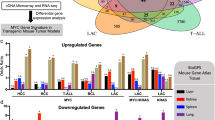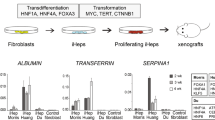Abstract
FIBROBLAST growth factors (FGFs) have been implicated in many aspects of cell growth and differentiation both in normal and neoplastic settings1,2. For example, the mouse int-2 gene, which encodes an FGF-related product3, is a frequent target of proviral activation in carcinomas induced by mouse mammary tumour virus4,5, but apparently functions at discrete stages of normal embryonic development6,7. Six classes of int-2 messenger RNA have been identified in embryonic cells, each of which is predicted to encode the same 245-amino-acid protein8–10. But all known int-2 transcripts include sequences upstream of the AUG codon presumed to be the initiation codon. Here we report an additional N-terminally extended int-2 gene product initiated at an in-frame CUG codon. In COS-1 cells transiently transfected with appropriate int-2 complementary DNAs, the AUG-initiated product is found predominantly in the secretory pathway, whereas the CUG-initiated form is localized to the nucleus. These data indicate that the Int-2 oncoprotein could influence cellular behaviour by two distinct mechanisms.
This is a preview of subscription content, access via your institution
Access options
Subscribe to this journal
Receive 51 print issues and online access
$199.00 per year
only $3.90 per issue
Buy this article
- Purchase on SpringerLink
- Instant access to full article PDF
Prices may be subject to local taxes which are calculated during checkout
Similar content being viewed by others
References
Gospodarowicz, D., Ferrar, N., Schweigerer, L. & Neufeld, G. Endocrine Reviews 8, 95–114 (1987).
Rifkin, D. B. & Moscatelli, D. J. cell. Biol. 109, 1–6 (1989).
Dickson, C. & Peters, G. Nature 326, 833 (1987).
Dickson, C., Smith, R., Brookes, S. & Peters, G. Cell 37, 529–536 (1984).
Peters, G. & Dickson, C. in Cellular and Molecular Biology of Mammary Cancer eds D. Medina et al. 307–319 (Plenum, New York, 1987).
Wilkinson, D. G., Peters, G., Dickson, C. & McMahon, A. P. EMBO J. 7, 691–695 (1988).
Wilkinson, D. G., Bhatt, S. & McMahon, A. P. Development 105, 131–136 (1989).
Moore, R. et al. EMBO J. 5, 919–924 (1986).
Smith, R., Peters, G. & Dickson, C. EMBO J. 7, 1013–1022 (1988).
Mansour, S. L. & Martin, G. R. EMBO J. 7, 2035–2041 (1988).
Dixon, M. et al. Molec. cell. Biol. 9, 4896–4902 (1989).
Hann, S. R., King, M. W., Bentley, D. L., Anderson, C. W. & Eisenman, R. N. Cell 52, 185–195 (1988).
Peabody, D. S. J. biol. Chem. 264, 5031–5035 (1989).
Yoshida, T. et al. Proc. nant. Acad. Sci. U.S.A. 84, 7305–7309 (1987).
Delli-Bovi, P. et al. Molec. cell. Biol. 8, 2933–2941 (1988).
Zhan, X., Bates, B., Hu, X. & Goldfarb, M. Molec. cell. Biol. 8, 3487–3495 (1988).
Harlow, E., Crawford, L. V., Pim, D. C. & Williamson, N. M. J. Virol. 39, 861–869 (1981).
Hortsch, M. & Meyer, D. Eur. J. Biochem. 150, 559–564 (1985).
Dingwall, C. & Laskey, R. A. A. Rev. Cell Biol. 2, 367–390 (1986).
Brookes, S., Smith, R., Casey, G., Dickson, C. & Peters, G. Oncogene 4, 429–436 (1989).
Prats, H. et al. Proc. natn. Acad. Sci. U.S.A. 86, 1836–1840 (1989).
Florkiewicz, R. Z. & Sommer, A. Proc. natn. Acad. Sci. U.S.A. 86, 3978–3981 (1989).
Bouche, G. et al. Proc. natn. Acad. Sci. U.S.A. 84, 6770–6774 (1987).
Yeh, H.-J., Pierce, G. F. & Deuel, T. F. Proc. natn. Acad. Sci. U.S.A. 84, 2317–2321 (1987).
Lee, B. A., Maher, D. W., Hannink, M. & Donoghue, D. J. Molec. cell. Biol. 7, 3527–3537 (1987).
Spence, A. M. et al. Proc. natn. Acad. Sci. U.S.A. 86, 7843–7847 (1989).
Kozak, M. J. Cell Biol. 108, 229–241 (1989).
Author information
Authors and Affiliations
Rights and permissions
About this article
Cite this article
Acland, P., Dixon, M., Peters, G. et al. Subcellular fate of the lnt-2 oncoprotein is determined by choice of initiation codon. Nature 343, 662–665 (1990). https://doi.org/10.1038/343662a0
Received:
Accepted:
Issue Date:
DOI: https://doi.org/10.1038/343662a0



